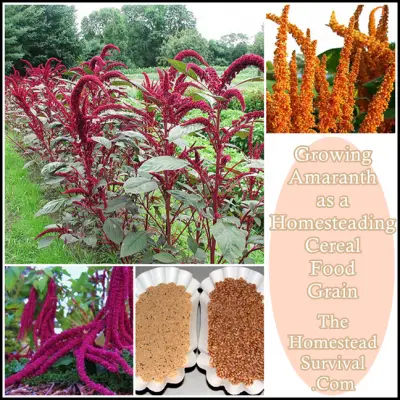There is plenty of attention towards amaranth, but why? Although tiny in size, the tan-colored seeds bring lots of nutrition that is unrivaled among cereal grains. It is an inexpensive crop that can be cultivated by homesteaders in rural areas for a handful of reasons. It is easily harvested, simple to cook and grow very rapidly even in harsh and lackluster nutrient soil conditions.
Amaranth plants comes in all sizes, shapes and colors. The leaves can be round or lance shaped, light green, dark green, reddish or variegated. Seeds maybe white, yellow, pink or black. Flowers can be huge tassels or tiny globes, red, pink, yellow or cream colored.
Having amaranth on your menu is one of the best defenses against cancer. Amaranth is full of magnesium, calcium iron, etc… It is also very high in protein and abundant in lysine. Lunasin, a bioactive peptide in amaranth, has proved to inhibit the development of cancer cells. Soy also contains lunasin, but lunasin in amaranth penetrates the nucleus of cancer cells more rapidly. Also, one of amaranth’s antioxidants compounds, squalene, may halt blood supply to tumors. Amaranth contains renowned minerals for keeping the bones strong, calcium, and magnesium, manganese, and phosphorus, also adding lysine. What is there with lysine that has to do with bones? Lots, helping the body absorb calcium and decrease the amount of calcium lost by urine. Plays a role in formation of collagen that is crucial for sturdy bones.
Anemia makes you pale and weak, and can cause headaches and poor appetite. Gaining low amount of iron in your diet can increase the chances of anemia. Amaranth has plenty of iron to keep anemia at bay.
A bowl of amaranth is also good for your heart. Rutin and nicotiflorin, the two polyphenols in amaranth, have established anti-inflammatory and antioxidant properties. Amaranth also helps in aiding the repair of damaged brain cells. Amaranth leaves are nutritionally similar to beets, Swiss chard and spinach but actually taste better.
To cook one serving of amaranth:
Bring 1 cup (250 mL) liquid to a boil, add 1/4 cup (60 mL) amaranth, cover and reduce to simmer. Cook for 20 minutes or until liquid is absorbed.
Nutritious breakfast:
Cook amaranth in milk and top with nuts and dried fruit.
Nutritious snack:
You can pop amaranth seeds just like popcorn. Popped amaranth makes a crunchy topping for salads and soups. It can also be mixed with honey, dried fruit, and nuts to make energy bars.
As flower:
Amaranth flour can be used for making pasta, flat breads, cookies, or muffins. Because it contains no gluten, it must be mixed with other flours when baking yeast breads.
In order to make homemade amaranth flour you will need to collect as many flower heads as possible. Lay them on a sheet over drying racks. They should be away from the soil and quickly dry on the sun. Run them through a simple hand crank flour shifter.
1 cup (250 ml) cooked amaranth contains:
Nutrient Amount
fiber 5.2g
protein 9.35g
iron 5.17mg
copper 0.37mg
selenium 13.5mg
niacin 0.58mg
folate 54mg
zinc 2.12mg
calcium 116mg
potassium 332mg
riboflavin 0.05mg
phosphorus 364mg
vitamin B6 0.28mg
Common grains such as wheat and corn are comparatively rich in amino acids that amaranth lacks; thus, amaranth and grains can complement each other. The seeds of Amaranthus species contain about thirty percent more protein than cereals like rice, sorghum and rye.
Please LOOK BELOW to read the remaining part of the article.

Click below to read about:
.

